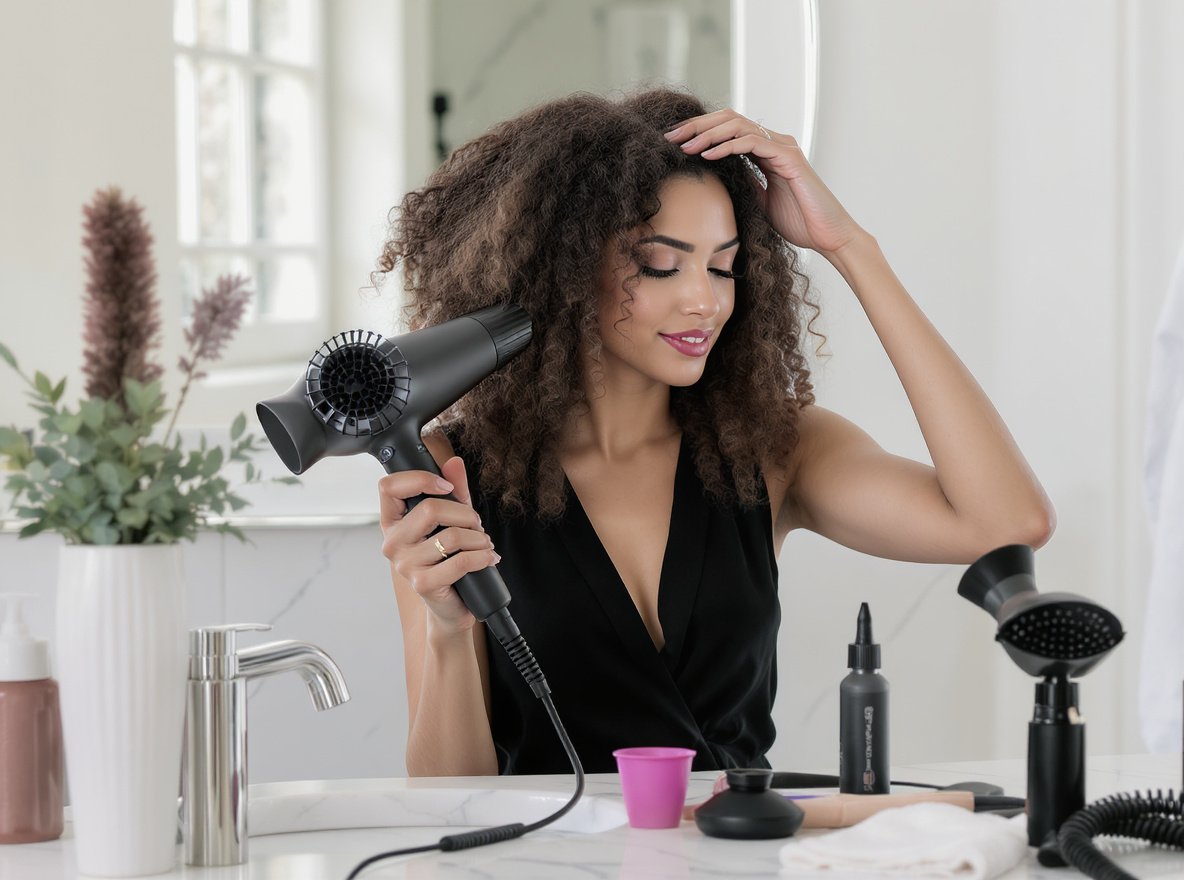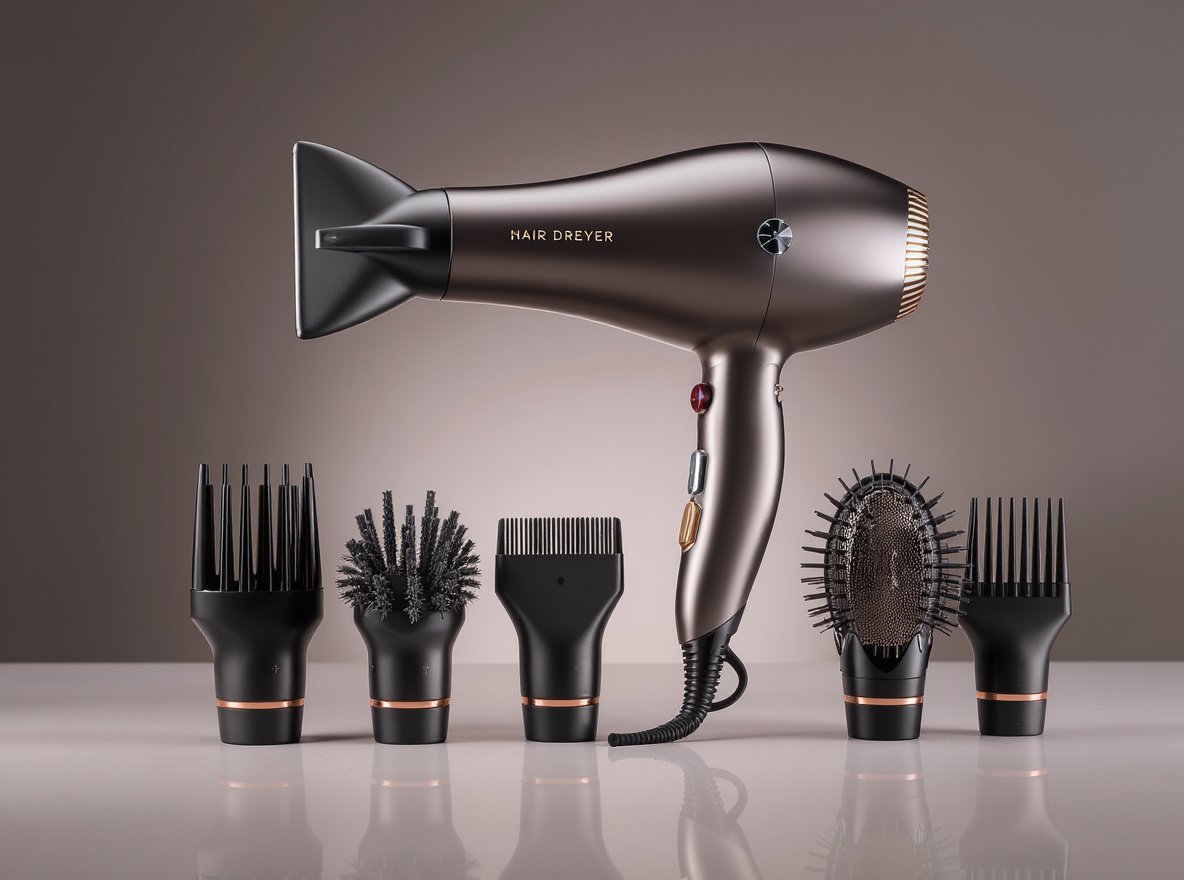Salon professionals constantly seek equipment that delivers superior results while protecting client hair health. The choice between infrared and traditional hair dryers significantly impacts both efficiency and hair quality outcomes for your salon business.
Infrared hair dryers utilize electromagnetic radiation to penetrate the hair shaft, heating it from the inside out with far-infrared wavelengths (2-8 μm) that are specifically absorbed by water molecules. This technology reduces drying time by 30-50% while operating at lower surface temperatures than traditional convection dryers, preserving hair cuticles and maintaining natural moisture levels.
Understanding these technological differences helps salon owners and wholesale buyers make informed purchasing decisions that benefit both stylists and clients.
Table of Contents
ToggleWhat Is the Core Technology Difference Between Infrared and Traditional Hair Dryers?
The fundamental heating mechanisms distinguish these two dryer types for professional applications.
Infrared hair dryers employ electromagnetic radiation using far-infrared wavelengths (typically 2-8 μm) that are specifically absorbed by water molecules in the hair. Traditional dryers rely on convection heating, using heated coils or ceramic elements to warm air that is blown onto the hair’s surface.

Infrared technology works by penetrating directly into the hair cuticle, creating even heat distribution throughout each strand. The electromagnetic energy travels into the hair shaft rather than simply heating the external surface, targeting water molecules for more efficient moisture removal.
Traditional convection dryers operate through external heating methods. Hot air flows over hair surfaces, gradually removing moisture through surface heat application. This process often creates hot spots and uneven drying patterns that can damage hair structure.
Key technological distinctions include:
• Heat Penetration: Infrared waves penetrate hair cuticles vs. surface air heating
• Energy Target: Direct water molecule absorption vs. external evaporation
• Heat Distribution: Even internal heating vs. external hot spots
• Wavelength Specificity: Optimized 2-8 μm range vs. broad-spectrum heat
| Technology Aspect | Traditional Dryers | Infrared Dryers |
|---|---|---|
| Heat Method | Convection (external) | Electromagnetic radiation (internal) |
| Target | Hair surface | Water molecules in hair |
| Heat Distribution | Uneven, external | Even, internal penetration |
| Wavelength | Broad spectrum | Optimized 2-8 μm far-infrared |
How Do Drying Times Compare in Professional Salon Settings?
Speed efficiency directly impacts salon productivity and client satisfaction levels.
Professional salon testing reveals infrared dryers reduce drying time by 30-50% compared to traditional models. The L’Oréal AirLight Pro achieves 30% faster drying while using 31% less energy, allowing salons to serve more clients per day while maintaining superior quality results.

Time efficiency becomes crucial for high-volume salon operations. Research consistently demonstrates significant performance advantages for infrared technology in professional environments, with some studies showing infrared dryers can cut processing time in half while maintaining superior results.
The inside-out heating approach targets moisture more effectively than surface heating methods. This efficiency improvement stems from direct water molecule activation rather than relying solely on external heat transfer to evaporate surface moisture.
Professional salon benefits include:
• Service Capacity: 30-50% faster drying enables more appointments per day
• Energy Efficiency: 31% less energy consumption reduces operational costs
• Consistent Results: Even heat distribution eliminates hot spots and over-processing
• Stylist Productivity: Reduced fatigue from shorter blow-drying sessions
The time savings translate directly to increased appointment capacity and improved salon profitability while reducing stylist fatigue from extended styling sessions.
What Are the Hair Health Benefits for Salon Clients?
Client hair condition affects salon reputation and repeat business potential.
Infrared dryers cause significantly less heat damage because they operate at lower surface temperatures while maintaining effective drying power. Clinical testing shows 33% shinier hair and 59% visually smoother results, with improved cuticle sealing that creates a protective barrier against humidity and environmental damage.

Hair health preservation becomes crucial for salon success and client retention. Infrared heat seals the hair cuticle, creating a protective barrier that traditional high-heat methods cannot achieve without causing thermal damage.
The inside-out heating process preserves natural oils and internal moisture content more effectively than surface heating. Lower surface temperatures minimize thermal damage to the hair’s outer layer while still achieving complete drying.
Professional stylists report improved client outcomes:
Cuticle protection occurs through gentle heating that seals rather than damages the hair’s protective outer layer. This sealing effect creates resistance to humidity and environmental factors that cause frizz and styling failure.
Enhanced shine and smoothness result from preserved cuticle integrity. The 33% improvement in shine and 59% increase in visual smoothness demonstrate measurable quality improvements that clients notice immediately.
Blood circulation to the scalp potentially improves through gentle infrared heat exposure, which may support overall hair health and growth patterns over time.
How Do Energy Efficiency and Operating Costs Compare?
Operational expenses significantly impact salon profitability and wholesale purchasing decisions.
Infrared hair dryers demonstrate 40% energy savings compared to traditional models while delivering superior performance. Professional traditional dryers consume 1,875-2,500 watts, while infrared equivalents like the Nicky Clarke Infrared Pro use only 1,300W while achieving faster drying times.

Energy consumption directly affects salon overhead costs and environmental sustainability goals. Modern salons increasingly prioritize equipment that reduces operational expenses while improving service quality.
Annual operating cost comparisons reveal significant savings:
Traditional 1,875W dryers cost approximately $400-500 annually in electricity for salons operating 8 hours daily. Infrared equivalents cost only $240-300 annually, saving $160-200 per dryer each year.
The Moroccanoil Smart Styling infrared dryer provides equivalent performance with 40% less energy consumption, demonstrating the dual benefits of efficiency and performance that make infrared technology financially attractive.
| Dryer Type | Power Consumption | Annual Cost* | Annual Savings |
|---|---|---|---|
| Traditional Professional | 1,875-2,500W | $400-500 | – |
| Infrared Professional | 1,300-1,500W | $240-300 | $160-200 |
| Energy Efficiency Gain | 40% reduction | 40% lower cost | Significant ROI |
*Based on 8-hour daily salon operation
Long-term operational benefits include reduced utility bills, lower equipment replacement frequency, and improved salon sustainability metrics that appeal to environmentally conscious clients.
What Features Should Salon Professionals Look for in Infrared Dryers?
Professional-grade features determine equipment suitability for high-volume salon operations.
Professional infrared dryers should include minimum 1,875W power output, professional-grade AC or BLDC motors rated for 1,000+ hours operation, multiple heat settings (minimum 3), ceramic or tourmaline heating elements, and lightweight design under 2 pounds. These specifications ensure versatility, durability, and stylist comfort in demanding salon environments.

Feature selection impacts both immediate performance and long-term operational success. Professional models offer advanced capabilities that consumer versions lack for high-volume commercial use.
Essential professional specifications include:
Power and Motor Requirements: Professional units require minimum 1,875W power output for adequate salon performance. Professional-grade AC or BLDC motors provide consistent power delivery and extended operational lifespan rated for 1,000+ hours of continuous use.
Advanced Technology Integration: Ceramic or tourmaline heating elements ensure even heat distribution throughout the infrared spectrum. Ionic technology integration provides additional frizz control and enhanced shine for superior styling results.
Ergonomic Design Features: Professional cord length (8-9 feet minimum) enables salon maneuverability. Lightweight construction under 2 pounds reduces stylist fatigue during extended use periods.
Safety and maintenance features include ALCI safety plugs for electrical protection, removable filters for easy maintenance, and cool shot buttons for style setting and cuticle sealing.
Professional attachment compatibility expands styling versatility for diverse client needs, including concentrators for precision styling and diffusers for textured hair types.
How Do Initial Investment Costs Compare for Salon Owners?
Purchase price considerations affect equipment budgeting and return on investment calculations.
Professional infrared dryers typically cost $50-150 more initially than traditional professional models, with premium units like the L’Oréal AirLight Pro at $475 compared to standard professional dryers at $80-300. However, the investment is recovered within 12-18 months through reduced energy costs, faster service times, and improved client satisfaction.

Cost-benefit analysis reveals that higher upfront investment generates substantial long-term savings and revenue improvements. Professional salon owners must consider total cost of ownership rather than just initial purchase price.
Investment comparison analysis:
Professional Infrared Pricing Range:
• L’Oréal AirLight Pro: $475 (premium professional model)
• Moroccanoil Smart Styling: $190-200 (professional grade)
• Hot Tools Pro Artist: $115 (mid-range professional)
• JINRI Professional Models: $150-200 (entry-level professional)
Traditional Professional Pricing:
• Standard professional models: $80-150
• High-end traditional units: $200-300
Return on investment accelerates through multiple revenue streams. Energy savings of $160-200 annually per dryer provide direct cost recovery. Faster drying times enable 30-50% more appointments, increasing daily revenue potential significantly.
Client retention improves when hair health outcomes exceed expectations, leading to increased repeat business and positive referrals that drive organic salon growth and premium service pricing opportunities.
What Training Do Stylists Need for Infrared Hair Dryer Technology?
Proper technique ensures optimal results and equipment longevity in professional settings.
Professional stylists report that infrared hair dryer technology requires minimal additional training, with most adapting within 1-2 weeks of regular use. Training focuses primarily on understanding lower heat settings for equivalent results and timing modifications for 30-50% faster drying speeds.

Training requirements remain manageable while maximizing technology benefits. The learning curve is minimal because infrared dryers operate similarly to traditional models with standard heat and speed controls.
Key training areas include:
Heat Setting Adjustments: Stylists must learn that infrared dryers work effectively at lower temperature settings than traditional models. Starting with reduced heat prevents over-processing while achieving superior results through the inside-out heating mechanism.
Timing Modifications: Understanding the 30-50% reduction in drying time prevents over-drying and thermal damage. Stylists need to adjust their sectioning techniques and movement patterns for more efficient heat distribution.
Hair Type Considerations: Different hair textures respond uniquely to infrared technology, requiring individualized approach modifications for fine, thick, damaged, or chemically treated hair.
Professional development recommendations include:
• Initial demonstration sessions on proper technique and optimal heat settings
• Hands-on practice with various hair types and textures to build confidence
• Client communication training to explain infrared benefits and justify premium pricing
• Maintenance instruction for filter cleaning and optimal performance preservation
Most salon professionals report immediate preference for infrared technology once familiar with its superior results and operational efficiency.
Summary
Infrared hair dryers represent a significant technological advancement for professional salon operations, offering 30-50% faster drying times, 40% energy savings, and superior hair health outcomes compared to traditional convection models. While requiring $50-150 higher initial investment, the benefits of improved efficiency, reduced operational costs, and enhanced client satisfaction create compelling return on investment within 12-18 months for forward-thinking salon owners and equipment distributors.

For salon professionals seeking cutting-edge equipment that delivers exceptional results with minimal training requirements, consider exploring advanced infrared technology options like the Laifex P1C High-Speed Hair Dryer, designed specifically for professional applications. Contact us today to learn more about wholesale opportunities and how our innovative hair drying solutions can enhance your salon’s service quality and operational efficiency.



